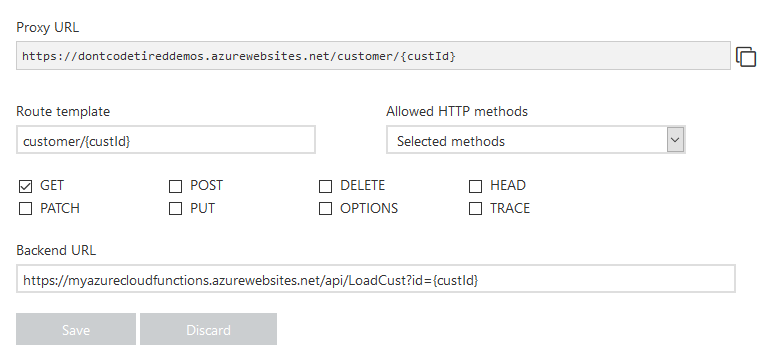In a previous article we saw how to get started with Azure Function Proxies. In addition to creating proxy URLs for HTTP functions in the same Function App, it is also possible to specifiy a backend URL that exists in a different Function App (or even a URL somewhere completely different). This essentially allows a single (HTTP) API for clients to use, that behind the scenes routes traffic to multiple Function Apps to enable the decomposing of a single large Function App into multiple smaller ones. This also enables isolation between different Function Apps for deployment, testing, management, monitoring, etc..
For example, suppose we have an HTTP function defined in a Function App called myazurecloudfunctions that GETs a customer using an id querystring parameter; a request for customer 42 would look like the following (with function authorization enabled):
https://myazurecloudfunctions.azurewebsites.net/api/LoadCust?id=42&code=SKmM3Hr0IFEdJp9QnQ5ztu/mClYScUxjdjQw4TvSQ9OXm0xrgXQUpg==
In another Function App called dontcodetireddemos a proxy can be created to enable the following URL to be used instead:
https://dontcodetireddemos.azurewebsites.net/customer/42?code=SKmM3Hr0IFEdJp9QnQ5ztu/mClYScUxjdjQw4TvSQ9OXm0xrgXQUpg==
Notice in this proxied URL the id 42 is specified in the URL, not as a querystring parameter. This is another feature of Azure Function Proxies that allows request parameters to be mapped from the proxy URL to the backend URL. In this example the proxy route template is “customer/{custId}” and the backend is set to “https://myazurecloudfunctions.azurewebsites.net/api/LoadCust?id={custId}” – notice the token {custId}.
The proxies.json configuration is:
{
"proxies": {
"CustomerGet": {
"matchCondition": {
"route": "customer/{custId}",
"methods": [
"GET"
]
},
"backendUri": "https://myazurecloudfunctions.azurewebsites.net/api/LoadCust?id={custId}"
}
}
}
And a screenshot of the configuration:

To jump-start your Azure Functions knowledge check out my Azure Function Triggers Quick Start Pluralsight course.
SHARE: